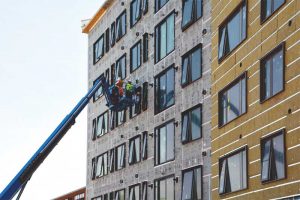
Ever more stringent energy code requirements have necessitated increased insulation levels; in many cases, this includes adding exterior insulation. Additional insulation thickness and changes to the insulation location require reconsideration with regards to vapor diffusion and condensation control.
Varying vapor permeability of different insulation products, membranes, and other building materials introduces significant complexity to wall assembly design. Some insulation materials, like stone wool and fiberglass, are vapor permeable, while others, such as extruded polystyrene (XPS), expanded polystyrene (EPS), polyisocyanurate, and closed-cell spray foam, are relatively impermeable.
Energy codes and building codes can be confusing as they relate to exterior insulation selection and moisture control for walls. A wall works by keeping the outside out and the inside in. According to Dr. Joe Lstiburek’s “perfect wall” principle, there is the water control layer, air control layer, vapor control layer, and thermal control layer all in the right places. Moisture to the inside of the vapor control layer dries inward while moisture to the exterior dries outward.
Selection of a particular arrangement of material layers, and the vapor permeance of those layers, will control vapor diffusion. Controlling vapor diffusion is one means of controlling condensation and the location of the dew point within the wall.
Another part of condensation management is having an airtight assembly that is vapor open in both directions. Place an airtight membrane, typically a water-resistive barrier that is also an air barrier, on the outside of the structural sheathing then cover the outside of that with another layer of vapor-open insulation. The wall can dry to the inside and outside. The term for this is a “flow-through assembly”. It is airtight, but vapor open on both sides with a semi-permeable control layer in the middle and a throttle at the air control layer. In the case of the flow-through assembly, the throttle would be the lowest permeable component, such as the oriented strand board (OSB) sheathing. It should be noted the ratio of exterior insulation R-value to total insulation R-value is critical in this case to control condensation due to vapor diffusion on the sensitive layers (typically the sheathing). This ratio must be calculated based on the indoor and outdoor climates to ensure the temperature of the sheathing (or any other moisture-sensitive layer) always remains above the dew point.
This article clarifies and provides guidance on vapor diffusion and condensation control in these new wall assemblies.
Understanding vapor diffusion
Vapor diffusion is the movement of water vapor molecules through porous materials (e.g. wood, insulation, drywall, concrete, etc.) driven by vapor pressure differences. Vapor pressure differences occur as a result of temperature and water vapor content differences in the air. Vapor diffusion flow always occurs through an assembly from the high- to the low-vapor-pressure side, which is often from the warm side to the cold side, as warm air can hold more water than cold air.
In cold climates, this means vapor diffuses primarily from the heated interior to the colder outdoors, whereas in hot climates, the vapor drive is reversed and instead flows primarily from the warm, humid exterior to the air-conditioned interior. The direction of vapor diffusion can also be reversed when the sun heats up damp, absorptive wall claddings like masonry, driving water vapor inward.
Overall, the direction of the vapor drive has important implications on the placement of materials within a wall assembly. The best tool for calculating vapor pressure differentials is the psychrometric chart.




